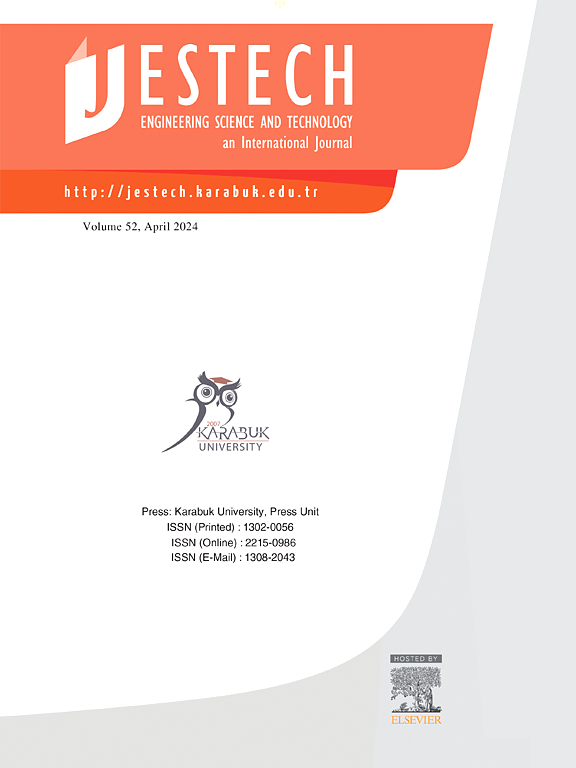Adaptive controller for multirotor based on estimated parameters
IF 5.1
2区 工程技术
Q1 ENGINEERING, MULTIDISCIPLINARY
Engineering Science and Technology-An International Journal-Jestech
Pub Date : 2025-07-10
DOI:10.1016/j.jestch.2025.102121
引用次数: 0
Abstract
This paper presents an innovative design of an adaptive control system for multirotors, unmanned aerial vehicles (UAVs) based on estimated parameters. A dynamic model of the UAV is derived by using the Newton–Euler method in terms of angular velocity. The derived model is then simplified into three separated-first-order linear differential equations, with coefficients derived from the combined effects of inertia, aerodynamic drag, gyroscopic effects, and angular rate, referred to as lumped parameters. To estimate those lumped parameters for designing controller, each simplified equation is restructured into a processing and measurement model. The states of these models are estimated by using the extended Kalman filter (EKF). A Proportional–Integral (PI) controller with control gains and dynamic and constant compensation, which are computed from the lumped parameters, is proposed to control the output of the simplified model. The entire multirotor controller is built and classified inner loop and outer loop as desired trajectory controller, altitude and thrust controller, attitude controller, adaptive angular velocity controller, and kinematics and dynamic controller. The proposed controller is simulated by using Matlab Simulink R2023b with circular and square trajectories with variable payload. The simulation results demonstrate that the proposed controller allows the multirotor to follow both desired paths successfully about 5 s. The steady-state error all axes in both paths is less than 0.02 meters. There is no significant fluctuation when UAV change payload and tracking direction. Moreover, the estimated parameters remain nearly constant at a steady state.
基于估计参数的多转子自适应控制器
提出了一种基于参数估计的多旋翼无人机自适应控制系统的创新设计方法。采用牛顿-欧拉方法建立了无人机的角速度动力学模型。然后将导出的模型简化为三个分离的一阶线性微分方程,其系数由惯性、气动阻力、陀螺效应和角速率的综合影响得出,称为集总参数。为了估计这些集总参数用于设计控制器,将每个简化方程重构为处理和测量模型。利用扩展卡尔曼滤波(EKF)对这些模型的状态进行估计。提出了一种具有控制增益和动态补偿和恒定补偿的比例积分(PI)控制器,该控制器由集总参数计算得到,用于控制简化模型的输出。构建了整个多旋翼控制器,并将内环和外环分为期望轨迹控制器、高度和推力控制器、姿态控制器、自适应角速度控制器、运动学和动力学控制器。利用Matlab Simulink R2023b对该控制器进行了圆形和正方形可变载荷轨迹的仿真。仿真结果表明,所提出的控制器可以使多转子在5 s左右的时间内成功地沿两条路径运动。两路径各轴的稳态误差均小于0.02米。当无人机改变载荷和跟踪方向时,无明显波动。此外,估计的参数在稳定状态下几乎保持不变。
本文章由计算机程序翻译,如有差异,请以英文原文为准。
求助全文
约1分钟内获得全文
求助全文
来源期刊

Engineering Science and Technology-An International Journal-Jestech
Materials Science-Electronic, Optical and Magnetic Materials
CiteScore
11.20
自引率
3.50%
发文量
153
审稿时长
22 days
期刊介绍:
Engineering Science and Technology, an International Journal (JESTECH) (formerly Technology), a peer-reviewed quarterly engineering journal, publishes both theoretical and experimental high quality papers of permanent interest, not previously published in journals, in the field of engineering and applied science which aims to promote the theory and practice of technology and engineering. In addition to peer-reviewed original research papers, the Editorial Board welcomes original research reports, state-of-the-art reviews and communications in the broadly defined field of engineering science and technology.
The scope of JESTECH includes a wide spectrum of subjects including:
-Electrical/Electronics and Computer Engineering (Biomedical Engineering and Instrumentation; Coding, Cryptography, and Information Protection; Communications, Networks, Mobile Computing and Distributed Systems; Compilers and Operating Systems; Computer Architecture, Parallel Processing, and Dependability; Computer Vision and Robotics; Control Theory; Electromagnetic Waves, Microwave Techniques and Antennas; Embedded Systems; Integrated Circuits, VLSI Design, Testing, and CAD; Microelectromechanical Systems; Microelectronics, and Electronic Devices and Circuits; Power, Energy and Energy Conversion Systems; Signal, Image, and Speech Processing)
-Mechanical and Civil Engineering (Automotive Technologies; Biomechanics; Construction Materials; Design and Manufacturing; Dynamics and Control; Energy Generation, Utilization, Conversion, and Storage; Fluid Mechanics and Hydraulics; Heat and Mass Transfer; Micro-Nano Sciences; Renewable and Sustainable Energy Technologies; Robotics and Mechatronics; Solid Mechanics and Structure; Thermal Sciences)
-Metallurgical and Materials Engineering (Advanced Materials Science; Biomaterials; Ceramic and Inorgnanic Materials; Electronic-Magnetic Materials; Energy and Environment; Materials Characterizastion; Metallurgy; Polymers and Nanocomposites)
 求助内容:
求助内容: 应助结果提醒方式:
应助结果提醒方式:


